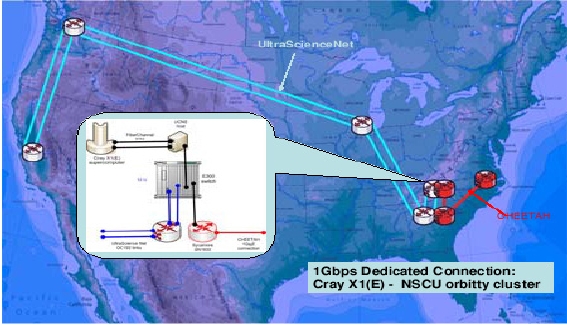California Institute of Technology (CalTech). It provides on-demand dedicated channels to
connect resources at multi-, single- and sublambda resolution. Users can utilize hosts located at
UltraScienceNet edges or connect to it through their own connections. Various types of protocols,
middleware and application research projects in support of DOE large-scale science applications
can make use of the provisioned dedicated circuits. Through these activities, USN serves as a
technology pathfinder and developmental platform for advanced networking technologies, which
will may deployed in production ESnet upon maturation. USN control-plane and management-
plane are deployed using a Virtual Private Network that provides protection against cyber attacks.
The control-plane is implemented using a centralized scheduler that (a) maintains the state of
bandwidth allocations on each link; (b) accepts and grants requests for current and future
channels to applications; and (b) sends signaling messages to switches as per the schedule for
setting up and tearing down the dedicated channels.
This network has been deployed in August 2005, and has been successfully utilized for high
bandwidth data transfers and/or dedicated customized channels to ORNL Cray X1(E)
supercomputer, FNAL storage systems. PNNL confocal microscopes, and to various remote sites
from 2005 Supercomputing show floor. In the current configuration, it provides on-demand end-
to-end guaranteed circuits with capacities ranging from 150 Mbps to 20 Gbps within minutes of
setup times. During the past years, USN has enabled researchers at FNAL to develop and test
advanced data transfer technologies, which achieved data rates 15 times faster compared to their
production ESnet connection. In collaboration with NSF CHEETAH network, USN provided a
achieved speeds of 1.4 Gbps, about 28 times faster than default rate.
Figure 99: Dedicated connection to ORNL Cray X1.
At Supercomputing 2005 (SC05) conference USN provided six 10 Gbps connections to the
conference show-floor to connect FNL, PNNL, SLAC, and CalTech, and ORNL to various SC05
booths. At any given time, USN provided an aggregate bandwidth of 60 Gbps to SC05 show-
floor. These USN circuits were extended to the conference show-floor using an advanced,
flexible network architecture developed by the USN engineering team at ORNL. This extension
was achieved by re-creating USN Seattle node on SC05 show floor in two days. The core
technology that made the dynamic provisioning possible is the USN control-plane that provides
on-demand and in advance dedicated channels by optimizing network bandwidth utilization
176

